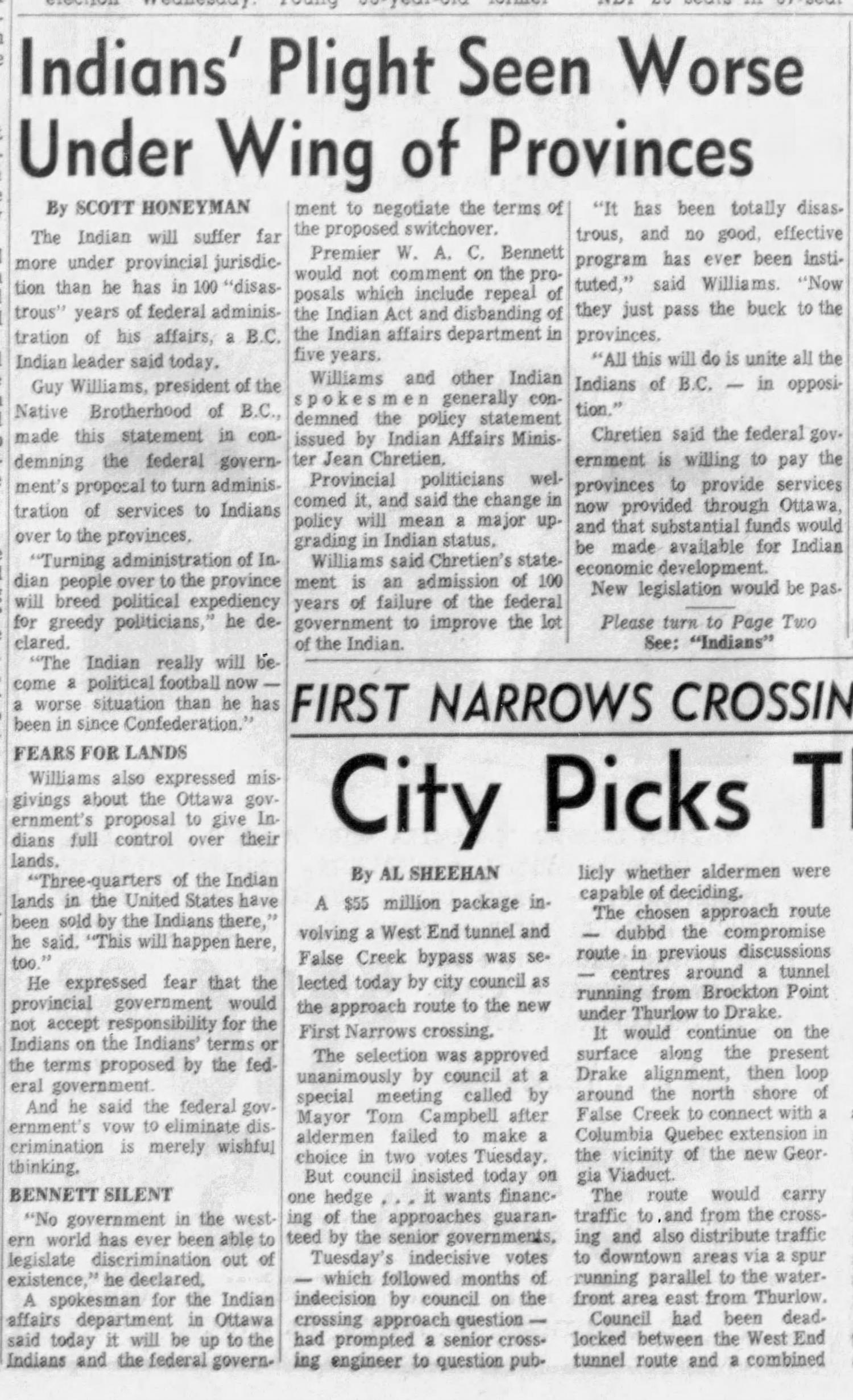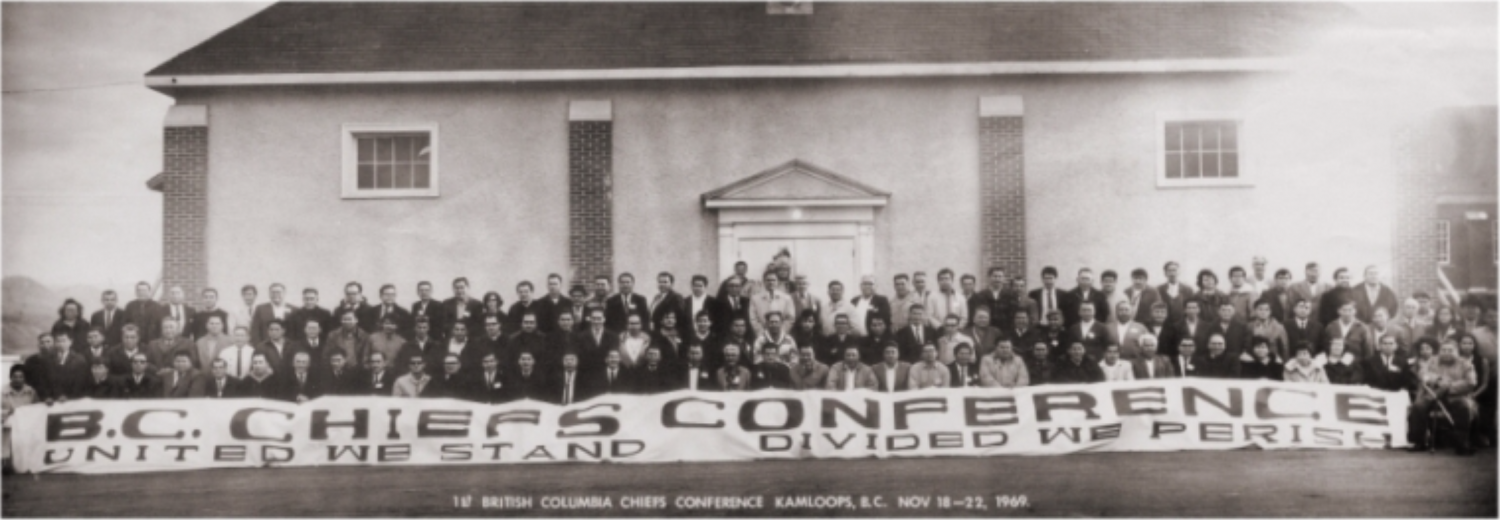The White Paper
Federal government attempts to fully assimilate Indigenous people, inviting a sharp rebuke from activists
Date: 1969
In June 1969, future Prime Minister Jean Chrétien, then head of Indian Affairs and Northern Development, unveiled a document called the Statement of the Government of Canada on Indian Policy. “To be an Indian is to be a man, with all a man's needs and abilities,” it began. As it’s now known, the White Paper went on to lament the vast hardship faced by Indigenous people in Canada, including unemployment, limited running water, and a lack of political and social power. “The course of history must be changed.”
Leading up to the White Paper, the federal government had asked the University of British Columbia anthropologist Harry B. Hawthorn to investigate the overwhelming inequality Indigenous people face. In his 1966 report, he recommended giving First Nations greater opportunity to strive independently while taking special care to help preserve Indigenous identities and ways of life. Subsequent government consultations with Indigenous communities highlighted various issues like Aboriginal rights, land title concerns, and self-determination. But the White Paper reflected neither Hawthorn’s recommendations nor the feedback of the population it espoused to help. Instead, it focused more on assimilation, a longstanding federal policy.
To achieve “full and equal participation in the cultural, social, economic, and political life of Canada,” the White Paper proposed eliminating “Indian” as a distinct legal status, making Indigenous people no different than any other Canadians in the eyes of government. This meant abolishing the notorious Indian Act, halting any rights and privileges offered by that nearly century-old legislation and converting reserves to private property that Indigenous bands could sell. The White Paper also proposed making “Indian” affairs the responsibility of provinces; offering funding for economic development; appointing a commission to resolve persisting land claims; and, significantly, eventually terminating existing treaties.
The White Paper was cloaked in progressive language intended to appeal to the growing social consciousness of the late 1960s. Its authors may have been well-intentioned. But the document was immediately chastised by Indigenous leaders across Canada. By effectively erasing Indigenous identity, many critics saw the White Paper as a tool to stymie First Nations’ efforts to have their Aboriginal rights and land claims recognized and respected just as this activism was gaining traction.
In British Columbia, the White Paper compelled Indigenous communities to form the Union of British Columbia Indian Chiefs (UBCIC), a vehicle to advance the myriad land claims across the province. In 1970, the UBCIC published their own rebuttal formally titled A Declaration of Indian Rights: The B.C. Indian Position Paper, or the Brown Paper. It emphasized the “immense moral and legal force” treaties and other historical arrangements between the federal government and Indigenous people carry: “To terminate this relationship would be no more appropriate than to terminate the citizenship rights of any other Canadian. This historic relationship cannot be abridged without our consent.”
Meanwhile, a young Cree activist from Alberta named Harold Cardinal said the policy proposal would lead to cultural genocide. “We will not walk this path,” he sternly wrote in his 1969 book The Unjust Society. A year after the White Paper came out, Cardinal and the Indian Association of Alberta released a lambasting of the White Paper called Citizens Plus, now popularly known as the Red Paper. “For the Indian to survive, says the government in effect, he must become a good little brown white man,” the Red Paper read. “The Americans to the south of us used to have a saying: ‘The only good Indian is a dead Indian.’ The MacDonald-Chrétien doctrine would amend this but slightly to, ‘The only good Indian is a non-Indian.’”
The uproar forced Prime Minister Pierre Elliott Trudeau's government to completely shelve the White Paper. “We’ll keep them in the ghetto as long as they want,” the frustrated prime minister reportedly sneered. But it didn’t end there. The government proposal had reenergized Indigenous activists, who continued to move the needle. In 1973, just four years after the federal government released the White Paper, Canada officially recognized Indigenous land claims for the first time ever. And when Trudeau repatriated Canada’s constitution in 1982 — when Britain transferred full constitutional authority to Canada and the Charter of Rights and Freedoms was introduced — Aboriginal and treaty rights were reaffirmed, a premise Trudeau himself had explicitly rejected only a decade before.
Sources:
- Crane Bear, Leon. "The Contemporary Relevance of the Historical Treaties to Treaty Indian Peoples." Active History, 1 Dec. 2015, http://activehistory.ca/papers/the-contemporary-relevance-of-the-historical-treaties-to-treaty-indian-peoples/.
- Government of Canada. "The Constitution Acts, 1867-1982: Rights of the Aboriginal Peoples of Canada." Justice Laws Website, 30 Apr. 2021, https://laws-lois.justice.gc.ca/eng/const/page-13.html#h-53.
- Joseph, Bob. "The Red Paper: A Counter-Punch to the White Paper." ICT_Logo_2018_982px-C, 11 July 2020, https://www.ictinc.ca/blog/the-red-paper-a-counter-punch-to-the-white-paper.
- "Stolen Lives: The Indigenous Peoples of Canada and the Indian Residential Schools." Facing History and Ourselves, https://www.facinghistory.org/stolen-lives-indigenous-peoples-canada-and-indian-residential-schools/chapter-8/white-paper-red-paper. Accessed 5 May 2021.
- The Union of B.C. Indian Chiefs. A Declaration of Indian Rights: The B.C. Indian Position Paper. 17 Nov. 1970, https://d3n8a8pro7vhmx.cloudfront.net/ubcic/pages/1440/attachments/original/1484861419/3_1970_11_17_DeclarationOfIndianRightsTheBCIndianPositionPaper_web_sm.pdf?1484861419.
- "The White Paper 1969." Indigenous Foundations, 2009, https://indigenousfoundations.arts.ubc.ca/the_white_paper_1969/.
- "Trudeau Gives Indians Categorical ‘No.’" The Province, 11 Aug. 1969, p. 7.




